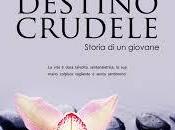

Dovete sapere che durante tutto il periodo vittoriano i gatti godevano di un'autentica ammirazione e venerazione, non esisteva casa o famiglia che almeno non ne avesse uno, e quasi mai capitava, cosa che, ahimè, spesso accade oggi, di vederne raminghi ai bordi delle strade; era allora considerato il gatto il vero ed autentico amico dell'uomo.
Non che il cane fosse surclassato, solo che ad esso era relegato un ruolo non meno importante, gli veniva chiesta collaborazione e complicità per la caccia, così come il cavallo era amato quale animale da compagnia con cui compiere lunghe passeggiate in mezzo alla natura.
Se infatti fino al secolo XVIII il gatto era considerato un indispensabile 'collaboratore domestico' in quanto dava il suo valido contributo nel mantenere le abitazioni sgombre da ospiti indesiderati, con l'ottocento, le case costruite con metodi sempre più rispettosi delle norme igieniche e civili condussero ad una svalutazione del gatto di casa in questo senso e ciò, unito alla ben nota sensibilità che connotò tutto il periodo vittoriano, agli studi Darwiniani che ne sostenevano l'educabilità ed al fatto che persino la regina Vittoria avesse due gatti da compagnia nel suo castello, lo fece promuovere ad amato e coccolato animale da salotto.
Tutto questo per giungere a dirvi che l'animale domestico da compagnia per eccellenza divenne il gatto, apprezzato in tutte le sue sfumature, generalmente a pelo corto, quello ritenuto più carismatico tra tutti era il soriano bianco e nero;


Dal film di Jane Campion Bright Star, 2009
e fu proprio questo amore per i nostri amici felini ad ispirare i Vittoriani che cominciarono con il riprodurli sempre più spesso, a partire dal tardo ottocento, in atteggiamenti e con caratteristiche umanizzate,
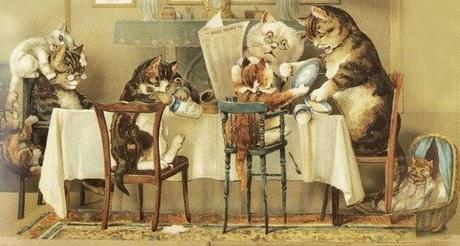 per giungere a vestirli come veri e propri esseri umani ( teniamo presente che il gatto non era un considerato un animale asessuato e perciò coprire il suo corpo con degli abiti significava obbedire al puritanesimo allora imperante ) in cartoline augurali,
per giungere a vestirli come veri e propri esseri umani ( teniamo presente che il gatto non era un considerato un animale asessuato e perciò coprire il suo corpo con degli abiti significava obbedire al puritanesimo allora imperante ) in cartoline augurali, 

 carte da parati, storie e racconti per l'infanzia, etc. ( Pensiamo a Beatrix Potter e alla sua Mrs. Tabitha Twitchit, per esempio )
carte da parati, storie e racconti per l'infanzia, etc. ( Pensiamo a Beatrix Potter e alla sua Mrs. Tabitha Twitchit, per esempio )

Furono persino create bambole di carta, ovvero gatti che si reggono sulle due zampe posteriori - con la postura da ominide - da ritagliare e vestite come vere e proprie bambole; sul finire del secolo, a Norimberga, città che poco meno di un secolo prima aveva dato i natali ai celebrati fratelli Grimm, Theodor Stroefer (1843 - 1927) pubblicò le illustrazioni di Arthur Thiele (1860 - 1936), abilissimo nel rappresentare ogni sorta di animale domestico con caratteristiche antropomorfiche, tra cui primeggiavano proprio i nostri simpaticissimi amici felini:
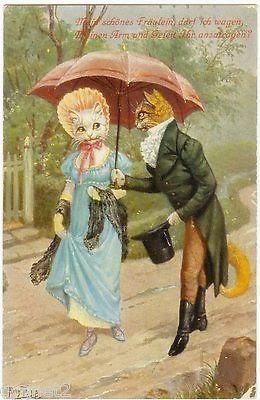

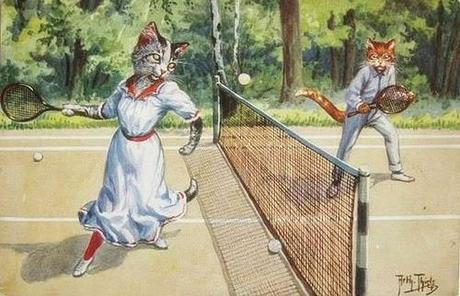
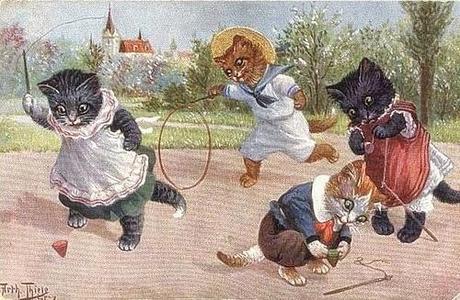







Queste cartoline, che già al loro tempo conobbero larghissima diffusione soprattutto negli Stati Uniti, sono considerate oggi preziosi oggetti da collezione, poiché hanno un valore molto elevato non esistendo ancora, allora, la produzione in serie.

All'incirca nello stesso periodo, proprio negli negli Stati Uniti, e per l'esattezza a Boston, nel Massachussets, contagiati da questo modo bizzarro d'interpretare l'amore per i gatti, vedeva la pubblicazione una rivista letteraria che raccoglieva racconti brevi di vario ed inusuale genere, dal titolo The Black Cat (1895 - 1922) illustrato da Capitain Geoffrey Spaulding celebre illustratore dell'epoca tardo vittoriana ed edoardiana il cui nome è principalmente legato ad immagini pubblicitarie o botaniche; di seguito vi mostro le copertine dei primi due numeri della suddetta rivista

 che già l'anno successivo mutò decisamente aspetto divenendone il gatto nero il protagonista assoluto !
che già l'anno successivo mutò decisamente aspetto divenendone il gatto nero il protagonista assoluto !

Concludo segnalandovi una pubblicazione non proprio recente, ma che appartiene al nostro tempo, che aggiunge materiale documentario e quindi immagini a questo meraviglioso mondo: a partire dagli anni novanta Susan Herbert si è dilettata nel rappresentare gatti sostituendoli ad attori, a personaggi rappresentati in famosi quadri del passato, da quelli impressionisti a quelli pre-raffaelliti, ad immaginare la vita di un gatto vittoriano:

Susan Herbert (illustrator) and Stanley Baron (author of the text),
Diary of a Victorian Cat,
Thames & Hudson Ltd, 1991
Con un caloroso abbraccio saluto tutti voi ringraziandovi infinitamente ed augurandovi, come sempre, ogni bene.
A presto ♥



- picture 1
- picture 2
You should know that along the whole Victorian period cats enjoyed a genuine admiration and reverence, there wasn't any home or family,that didn't had one at least, and certainly it didn't happened, as, alas, it often happens today, to see cats wandering at the edges of the roads; at that time cat was considered the true and genuine friend of a man.
Not that the dog was outclassed, only he was relegated to a role not less important, he was asked for collaboration and complicity for hunting, as well as the horse was loved as a companion animal with which to take long walks in the countryside.
If, in fact, until the eighteenth century, the cat was considered an essential 'domestic worker' as gave his valuable contribution in keeping the houses free from unwanted guests, with the nineteenth century, with houses built with methods more and more respectful of the rules of hygiene and civilization, brought to a devaluation of the domestic cat in this regard and this, combined with the well-known sensitivity that characterized throughout the Victorian period, along with the Darwinians studies which supported his educability, and the fact that even Queen Victoria had two cats inside her castle, did promoted him as a loved and pampered pet.
All this to tell you that the pet companion par excellence became the cat, appreciated in all his nuances, but generally always short-haired - the most charismatic was considered black and white tabby
- picture 3 - picture 4: from the film by Jane Campion Bright Star, 2009
and it was this love for our feline friends to inspire Victorians who began, more and more often, from te end of the XVIII century onwards, to 'give' them humanized attitudes and characteristics.
- picture 5
till putting clothes on them as real human beings ( we have to keep in mind that the cat wasn't considered an asexual animal and therefore to cover his body with clothes meant to obey the rules of the Puritanism ) in greeting cards,
- picture 6
- picture 7
- picture 8
wallpapers, tales for children, etc. (we do have to remember, by the way, Beatrix Potter and her Mrs. Tabitha Twitchit, for example)
- picture 9
- picture 10
They were even created paper dolls, or, better, cats standing on both hind legs - with the hominid posture - to cut out and dress like real dolls; at the end of the century in Nuremberg, the town that less than a century earlier had given birth to the celebrated Brothers Grimm, Theodor Stroefer (1843 - 1927) published the illustrations by Arthur Thiele (1860 - 1936), an expert who excelled in representing all sorts of pet with anthropomorphic characteristics, including own delightful feline friends:
- picture 11
- picture 12
- picture 13
- picture 14
- picture 15
- picture 16
- picture 17
- picture 18
- picture 19
- picture 20
- picture 21
These cards, which, at their time, already knew a very wide diffusion, especially in the United States, today are considered valuable collectibles, as they have a very high importance for in the Victorian age the mass manufacture didn't exist yet.
- picture 22
Around the same time, just in the United States, and to be exact in Boston, Massachusetts, 'infected' with this bizarre way to feel and interpret the love of cats, saw its publication a literary magazine that collected short stories of various and unusual kind, entitled The Black Cat (1895 - 1922) illustrated by Capitain Geoffrey Spaulding celebrated illustrator of the late Victorian and Edwardian age, whose name is primarily related to advertising or botanical images; I'm going to show you the covers of the first two numbers of the aforesaid magazine
- picture 23
- picture 24
that in the following year significantly changed appearance, becoming the Black Cat the absolute protagonist!
- picture 25
- picture 26
I conclude reporting you a not very recent publication, but that belongs anyway to our time, which adds documentary material and then images to this wonderful world: since the nineties Susan Herbert delight herself representing cats replacing actors, characters depicted in famous paintings of the past, such as the Impressionists or the pre-Raphaelites ones, to arrive to the point to imagine the life of a Victorian cat:
- cover
Susan Herbert (illustrator) and Stanley Baron (author of the text),
Diary of a Victorian Cat,
Thames & Hudson Ltd, 1991
With a warm hug I greet all of you thanking you so much and wishing you, as usual, all the best.
See you soon ♥


